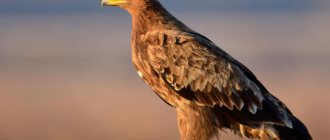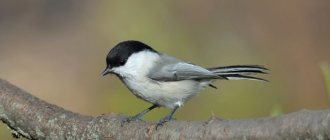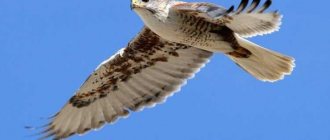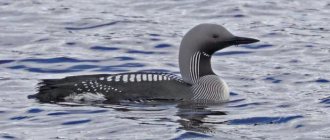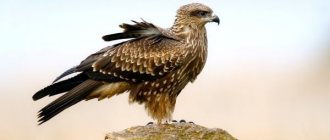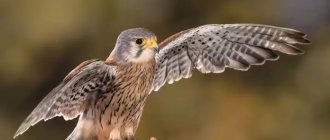The order Craniformes includes birds that live on the ground or swamps. This includes the following bird species:
- rail (small);
- cranes (large);
- Bustards (terrestrial).
Crane-like birds have characteristic body features. These are high legs, a thin, long neck and a sharp, straight beak. The weight of birds ranges from 2-15 kilograms. Crane-like birds mainly live on the ground in marshy areas. They do not sit on trees and swim very rarely. During flight, birds slowly flap their wings and can soar in the air for a long time, with their neck and legs extended in a line.
Bustard family
A fairly large family of birds, which includes several dozen species. The size of bustards can reach one meter in height, which makes them the largest representatives of flying birds. However, bustards prefer to spend most of their time on the ground. The basis of their diet is plant foods. Bustards nest on the ground, without using bushes and trees for these purposes. Some species can gather in large flocks of up to several thousand individuals.
Bustard Kori
Bustard
Jack
Great Bustard
Little Bustard
Description and features
Cranes are a whole family that is part of the crane-like order. The latter includes a large number of representatives of the feathered fauna, different in structure, behavior and appearance, having a very ancient origin, some of which are now extinct.
The crane is a tall bird with long neck and legs. Outwardly, such creatures are similar to storks and herons that are related to them, albeit very distantly. But unlike the former, cranes do not have the habit of nesting in trees, and they are more graceful.
And they can be distinguished from the second type of birds by their manner of flying. After all, when moving in the air, they have the habit of stretching their necks and legs, which are noticeably longer than those of herons. The head of such birds is quite small, the beak is straight and sharp, but proportionally smaller than that of the stork.
When they are on the ground with folded wings, their tail gives the impression of being lush and long due to the somewhat elongated flight feathers. The color of these winged creatures is usually white or gray.
Most species of cranes have an interesting feature. They have brightly colored areas of unfeathered skin on their heads. All other details of the appearance can be seen in the photo of the crane .
It is believed that the ancestral home of this type of birds is America, from there they moved to Asia in prehistoric periods, and later further spread to other regions of the world. Although today these birds are not found in the southern part of the American continent, just like in Antarctica. But they have taken root perfectly on all other continents of the planet.
The cry of a crane in the spring is usually heard far away, ringing loudly throughout the surrounding area. At this time of year, birds usually trumpet in duets. They play something like a repeated: “Skoko-o-rum.” In other periods, the crane's voice sounds completely different.
Such an inviting cry is usually called a purr. Usually two voices also participate in this roll call.
Thanks to their beauty and grace, cranes have left a living mark on the culture of various peoples of the earth and are mentioned in legends and myths. They became heroes of legends and magical stories of North American Indians.
Legends about them are found in the oral literature of the peoples of the Celestial Empire, Saudi Arabia and the Aegean coast.
The fact that our wild ancestors were familiar with them is evidenced by rock paintings and other very interesting finds of archaeologists. But now the crane population has suffered significantly, and its numbers are constantly declining. And this is especially true for varieties that will be mentioned and noted as rare below.
Other crane-like birds
sun heron
Kariama
Kagu
Trumpeter
Arama (Rapid Crane)
Types of cranes
As part of the crane family, which appeared on Earth at a time when dinosaurs still roamed it (according to some sources, about 60 million years ago), there are four genera, which are divided into 15 species.
Seven of them are found on Russian territory. Members of each variety have their own characteristics and are interesting in their own way. Let's look at some of them.
1. Indian crane . Representatives of this species are considered the tallest among their fellows. Their length is about 176 cm. The wings of these creatures have a span of 240 cm. Such birds have bluish-gray plumage, reddish legs; their beak is pale green and long. They live in India and are also found in other nearby areas of Asia. Such birds have been seen in small numbers in Australia.
2. Australian crane . Outwardly similar to the previously described crane, so much so that some time ago ornithologists classified these two representatives of the winged fauna as the same species. However, the feather cover of such birds is still a little darker.
The size of the Australian variety is only slightly inferior in size to its Indian counterparts. The height of specimens of this species is about 161 cm.
3. The Japanese crane is considered the heaviest among its relatives. The weight of some individuals reaches 11 kg. Representatives of this species live not only in Japan, but are also found in the Far East. A significant part of their plumage is white.
Only the neck and the back of the wings are contrasting with them (black), as well as the legs of such birds have a dark gray color. This species of the presented family is extremely small in number. Today, there are no more than two thousand such cranes left, and therefore the species is threatened with complete extinction.
4. Demoiselle crane . This species is notable for the fact that its representatives are the smallest in the crane family. They weigh about 2 kg or a little more, and their height usually does not exceed 89 cm. The name of the bird is not deceptive, it is really very beautiful.
The main background of the feathers of these creatures is bluish-gray. Some of the wing feathers are gray-ashy. The legs are dark, which goes well with the feathers of the head, which, like the neck, have a black tint. Their eyes and yellowish, short beak stand out like red-orange beads on their heads.
But what gives these birds a particularly flirtatious appearance are the long white tufts of feathers hanging from their heads to their necks in the shape of a crescent. Representatives of this species are widespread and are found in many regions of Eurasia, as well as on the African continent.
The sounds made by these beautiful creatures are a ringing, melodic high-pitched cooing.
5. The white crane (Siberian Crane) is endemic to the northern regions of our country. But even in Russia the species is considered critically rare. This bird is quite large, has a wingspan of two meters or more, and individual specimens of the species can reach a weight of more than 8 kg.
The birds have a long red beak and legs of almost the same shade. The main part of the plumage, as the name suggests, is white, with the exception of some wing feathers.
6. The whooping crane is far from a small member of the family. Such birds are found only in Canada, and in a very limited area, because, unfortunately, the species is catastrophically rare. The main part of the plumage of such birds is snow-white, with the exception of some black additions.
7. Black crane . This is also a very small variety, as noted in the Red Book. This crane lives in Eastern Russia and China. Until recently, the species was little studied. Its representatives are small in size and weigh on average just over 3 kg. The feather color of these creatures is mostly black, with the exception of the neck and part of the head, which are white.
8. African demoiselle is a resident of South Africa. The bird is small and weighs about 5 kg. The gray-blue tint is the main background of the feathers of such creatures. Only the long feathers at the end of the wing are lead-gray or black. These birds are also called paradise cranes.
9. The crowned crane is also an African inhabitant, but is distributed only in the eastern and western regions of the continent. This creature, in comparison with its relatives, is of medium size, and has a very exotic appearance. Its feathers are mostly black with light and red additions. The crane is called crowned crane because of the large golden crest adorning its head.
10. Gray crane . This large representative of the family is an inhabitant of the expanses of Eurasia. The main part of its plumage has a bluish-gray tint. The rump and back are somewhat darker, and the black ends of the wings also stand out in color. This species ranks second in number and distribution after the sandhill crane.
Reproduction and lifespan of cranes
Migrating cranes, returning to their future nesting sites, perform a special dance, which is accompanied by birdsong. These graceful creatures move with a prancing gait, flapping their wings and jumping.
Such dances on the eve of the mating season are so impressive that they were adopted by man. For example, in Japan and Karya there was a special cult dance, the performers of which imitated the movements of such birds.
Among cranes, it is customary to maintain devotion to a partner until his death, and therefore pairs of these winged creatures do not break up without a good reason. Representatives of migratory species usually choose partners for themselves while still in their wintering grounds.
Settled cranes that inhabit areas with a favorable climate, as a rule, breed during the wet period, since they do not experience a shortage of food at this time, which is important for the birth and raising of chicks.
Cranes hide their large nests (they have a diameter of up to several meters) in dense grass growing in secluded corners on the banks of reservoirs or in swamps. To build them, they use simple building materials: twigs and sticks; for landscaping, dry grass.
Typically, the clutch of most species consists of two eggs, only some varieties have up to five. Eggs come in various colors. They can be, for example, white or light blue, but most often the surface of the egg is covered in abundance with pigment spots.
Hatching lasts about a month, and then the crane babies hatch, covered with down. But the chicks are covered with real feathers only after a few months. The younger generation is growing up quickly. But its representatives reach sexual maturity no earlier than after four years (for Siberian Cranes no earlier than six years).
the crane boasts an enviable longevity. The lifespan of such birds in natural conditions is estimated at 20 years or more, and similar winged creatures kept in captivity, in some cases, live up to 80 years.
